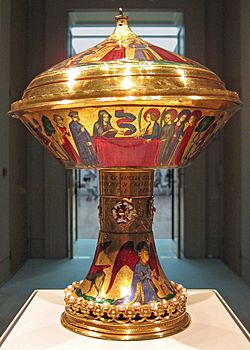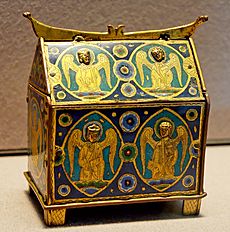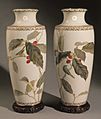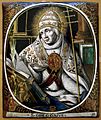Enamel (glass) facts for kids

- For other uses of the word, see Enamel
Enamel is made of melted glass, often on metal. Sometimes called vitreous or porcelain enamel, it is made by fusing powdered glass to a base by firing, usually between 750 and 850°C (1,380 and 1,560°F). The powder melts, flows, and then hardens to a smooth, durable coating on metal, or on glass or ceramics.
It has been used on decorative objects for two or three thousand years, but especially in the Middle Ages in Europe. In the 19th century, it was used on everyday objects such as kitchen equipment and road signs. The glass is hard-wearing, scratch resistant and easy to clean.
Images for kids
-
Chinese dish with scalloped rim, from the Ming Dynasty; early 15th century; cloisonné enamel; height: 2.5 cm, diameter: 15.2 cm; Metropolitan Museum of Art (New York City)
-
Staffordshire Moorlands Pan, 2nd-century Roman Britain
-
Chinese cloisonné enamel bronze wine pot, 18th century
-
Imperial vases by Ando Jubei, with the chrysanthemum crests of the Imperial family, using moriage to slightly raise the design; Khalili Collection of Japanese Art
-
Silver, silver gilt and painted enamel beaker, Burgundian Netherlands, c. 1425–1450, The Cloisters, nyc
-
Limoges? grisaille painted Stations of the Cross, Notre-Dame-des-Champs, Avranches
-
St. Gregory the Great in painted Limoges enamel on a copper plaque, by Jacques I Laudin
See also
 In Spanish: Esmalte para niños
In Spanish: Esmalte para niños




















